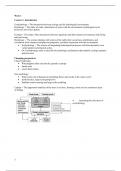Week 1
Lecture 1: Introduction
Ecohydrology = The interaction between ecology and its hydrological environment.
Hydrology = The study of water, interactions of water with the environment, hydrological cycle
processes, and water quality.
Ecology = The study of the interactions between organisms and their natural environment, both living
and non-living.
Hydrology = The science dealing with waters of the earth, their occurrence, distribution, and
circulation, their chemical and physical properties, and their interaction with the environment
• Ecohydrology = The science of integrating hydrological processes with biota dynamics over
varied spatial and temporal scales.
• Or: Ecohydrology seeks to describe the hydrologic mechanisms that underlie ecologic patterns
and processes
Changing perspectives
Classic hydrology:
• What happens after rain hits the ground or canopy
• Small scale
• Local observations
New hydrology:
• What is the role of humans in perturbing fluxes and stocks in the water cycle?
• Earth Science, large-scale perspective
• Satellite remote sensing and large-scale modeling
Canopy = The uppermost branches of the trees in a forest, forming a more or less continuous layer
of foliage.
• Increasing the relevance of
ecohydrology
1
, • Evaporation is affecting all three balances
o Carbon: photosynthesis, respiration
o Energy: cooling factor
o Water: how much water is going back
to the atmosphere
2
,Lecture 2: Evaporation
Goals of lecture:
• Describe and quantify the different components of evaporation
• Explain the methods for measuring evaporation
• Understand the drivers of evaporation
• Describe the interception process and its measuring techniques
Evaporation = Transport of water from the surface to the atmosphere.
Liquid → vapor, from oceans/water to atmosphere.
Different components of land evaporation
• Open-water evaporation
o Pan evaporation
▪ Available energy, The amount of energy
put into the water (radiation from the sun)
▪ Transfer of vapor, Wind (it takes the
moisture away, has influence on vapor
radiant)
• Bare soil evaporation
• Dry canopy evaporation
o = transpiration
o From inside the plants (plant is dry)
• Wet canopy evaporation
o = interception
o From outside of the plants (water on the plant so
the plant is wet)
Comparing the percentage of the world's land surface evaporation
across different continents (on the left) and biomes (on the right).
Transpiration is almost always most important
→ unless there is little vegetation
1. Transpiration (the lightest shade).
2. Interception Loss (second lightest shade).
3. Soil Evaporation (darker shade).
4. Sublimation (darkest shade, if present).
- Continents: Africa shows the highest percentage of the world's
land surface evaporation, followed by Asia and South America.
Antarctica and Europe have much lower contributions to global
evaporation.
- Biomes: The tropical forests contribute the most to global
evaporation, particularly in the form of transpiration, while
deserts and croplands contribute less. Tundra and boreal forests exhibit notable differences in the type
of evaporation, with some showing higher interception loss or sublimation.
Transport
Transport of vapor as a function of:
• Humidity gradient (as a function of temperature)
3
, o How fast it will escape
o If there already are a lot of molecules, it will take longer
• Wind speed across the surface
A schematic diagram of the flux of water molecules over a water surface, describing the processes of
evaporation and condensation.
1. Water surface: Represented at the
bottom, with water molecules rising
above the surface.
The diagram illustrates the interaction
between water vapor and the water
surface, driven by differences in vapor
pressure.
If the air is unsaturated (i.e., \( e_a <
e_s^(T_s) \)), evaporation
predominates, where water molecules
escape from the surface into the
atmosphere. Conversely, when the air
is saturated or oversaturated (i.e., \( e_a > e_s^(T_s) \)), water molecules condense back onto the
surface.
• B(u):
• depending on wind and surface roughness
Exam: don’t need to know all the formulas but need to understand them and know what the parameters
are, will need to calculate with some of them.
Energy balance
• conservation of energy
Turbulent fluxes: what energy gets in comes out,
energy sum needs to be equal.
• If you rearrange the formula you get evaporation
H = sensible heat
G = ground heat flux, energy that goes deeper in the ground/water (mostly in exercises it is 0 or will be
given)
Latent heat = energy that doesn’t cause a change in temperature, only in phase. (Is basically
evaporation)
Sensible heat = causes change in temperature, what we feel
(turbulent fluxes)
• When a lot of energy is lost as sensible heat it means the temperature is rising
Combination
4




